Материалдық құйылтым жүйесі Кеңістік пен орналасу шектеулері

Кеңістікті тиімді пайдалану үшін материалдарды тасымалдау жүйелерін оңтайландыру мен ғимараттың шектеулеріне сәйкестендіру үшін стратегиялық кеңістікті жоспарлау маңызды. Негізгі қиыншылықтарға: вертикаль кеңістіктің шектеулілігі, жұмыс аймағының пішінінің дұрыс еместігі, жұмыс үрдістерінің өзгеріп отыруы жатады.
Тасымалдағыштың конструкциясында кеңістікті пайдаланудың ең жоғары деңгейіне қол жеткізу
Қазіргі тасымалдағыштардың орналасуы кеңістіктің шектеулілігіне қарсы тұру үшін вертикаль бағаналар мен көп деңгейлі конфигурацияларды пайдаланады. Тиімді шешімдерге:
- Сатылы өнім ағыны үшін Z-тәрізді тасымалдағыштар
- Өңдеу аймақтары арасындағы құламалы беру құбырлары
- Тығыз орында жүруді қамтамасыз ететін 90° айналуы бар электр жетегі бар роликті жүйелер
Ғимараттың нақты орналасу шектеулерімен жұмыс істеу
Қисық белдік жүйелері (15°-45° доға мүмкіндігі) ғимараттардың бұзылған пішіндеріне бейімделеді, ал спиральды тасымалдағыштар төменгі өтетін бөліктерде (14 фут төбе) вертикаль тасымалдау мәселелерін шешеді. Баптау 24/7 жұмыс режимінде 98% дейінгі үздіксіздікті сақтайды.
Икемді материалдарды өңдеу үшін модульдік жобалар
Пәкетті қосу компоненттері жылдам қайта баптауға мүмкіндік береді:
- Тез ажыратылатын жетек блоктары (5 минуттан аз ауыстыру уақыты)
- Телескоптық рельстермен ыңғайланатын аймақтарды жинақтау
- Автоматты түрде деңгейлесетін жылжымалы негізгі блоктар
Модульдік жүйелер баптау уақытын күндерден сағаттарға дейін қысқартады және тұрақты орнатылған жүйелерге қарағанда орналасу құнын 18 доллар/фут² дейін азайтады.
Тасымалдау жүйесін таңдаған кезде материалдың сипаттамалары

Тасымалдағыштың ең жақсы жұмысы үшін бөлшектерді талдау
Бөлшек өлшемі әсер ететін фактор болып табылады:
- <5 мм материалдар вибрациялық тасымалдағыштарда 15-20% жоғары өткізгіштікке ие
-
10 мм дұрыссız бөлшектер тізбекті жетеге ие механизмдерді талап етеді
Нақты уақыт режиміндегі бөлшек сенсорлары фармацевтикалық қолданыстарда сепарацияны 40% қысқартады
Ұнамсыз және қауіпті материалдарды қауіпсіз тасымалдау
Ұнамсыз компоненттерге қажетті шарттар:
- ±0,1 м/с дәлдікпен жылдамдықты бақылау
- 2 G-күшінен төмен соққы күші
Қауіпті материалдар үшін талаптар:
- Үздіксіз дәнекерленген болат конвейерлер (98% дейінгі қамту)
- Электрстатикаға тұрақты тасымалдау ленталары (бетінің кедергісі <10^9 Ом)
Материал түрі бойынша өткізу қабілетін оптимизациядау
| Материал қасиеті | Конвейер түрі | Өткізу қабілетінің диапазоны | Энергия тиімділігі |
|---|---|---|---|
| Еркін ағатын ұнтақтар | Пневматикалық | 5-50 тонна/сағат | 8-12 кВтсағ/тонна |
| Біріктіруші гранулалар | Шаршы | 2-20 тонна/сағат | 15-22 кВтсағ/тонна |
| Үйкеліске тұрақты жабдық | Белбеу | 20-500 тонна/сағат | 3-7 кВтсағат/тонна |
| Жоғары температурадағы шлактар | Апрон | 10-150 тонна/сағат | 18-30 кВтсағат/тонна |
Таза заттар үшін азық-түлік сапалық қоспаларына арналған ЖЖҚП полиэтилен таспаларын (99,7% тазалық) қолдану қажет.
Материалдарды тасымалдау жүйелері үшін энергия тиімділігін арттыру
Конвейерлер өнеркәсіптегі энергия тұтынудың 15-30% құрайды. Қазіргі заманғы жаңартулар өнімділікті және тұрақтылықты теңестіреді.
Энергия тұтынуын азайту үшін ақылды автоматтандыру
Айнымалы жиілікті жетектер (VFD) төмен сұраныс кезінде энергия пайдалануды 40% дейін азайтады. Интернет негізіндегі жүктеме датчиктері өткізу қабілетін нақты уақытта реттейді, ал машиналық оқыту тарихи үлгілерге сәйкес реттеулерді тиімді етеді.
Материалдармен жұмыс істеуде тұрақты даму принциптері
Энергияны қалпына келтіру жүйелері тежеу үйкелісін қуатқа айналдырады. Тұйықталған суыту және биополимер белдіктер цикл бойынша шығындарды 18-27% төмендетіп, жөндеу шығындарын жылына 0,08-0,12 доллар/түзу фут қысқартады.
Сақтау қоймаларын жүйелерін интеграциялау стратегиялары
Конвейерлік басқару жүйесінің үйлесімділігін тексеру
Стандартталған API негіздемелері интеграциялық қателерді 40% төмендетеді. Жүктеме симуляциясы тауар айналымының ең жоғарғы кезінде синхрондауды тексереді.
Көне материалдарды тасымалдау инфрақұрылымын қайта жаңарту
Кезеңді жаңарту толық қайта жобалауға қарағанда ROI-ді 25-30% тезірек қамтамасыз етеді. Модульді компоненттер жүйені толық тоқтатпай-ақ энергия үнемдеуші жетектерді ауыстыруға мүмкіндік береді.
Материалдарды тасымалдау жүйелері үшін қауіпсіздік пен жөндеу протоколдары
Конвейерлер үшін алдын ала жөндеу талаптары
Негізгі протоколдар:
- Күнделікті визуалды тексеру
- Тоқсандық майлау циклдары
- Жыл сайынғы лазерлік нысанау тексерулері
Цифрлық журналдар қағаз жүйелерге қарағанда сәйкестікті 57% арттырады.
Конвейер жылдамдығының жұмыс қауіпсіздігіне әсері
| Жылдамдықтың артуы | Қауіпсіздік қатерінің көбейткіші |
|---|---|
| 10% | 1,5– |
| 25% | 3,2– |
| 50% | 6,8– |
Жасанды интеллектпен басқарылатын жылдамдықты реттеу жабылуға байланысты апаттарды 42% азайтады. OSHA жоғары өтімділікті желілер үшін де қауіпсіздік буферлерін сақтауды ұсынады.
Материалдарды тасымалдау жүйесіне инвестицияның ТСО талдауы
ROI-ді өнімділікті арттыру шығындарымен теңестіру
Жоғары әсерлі конвейерлер ұсынады:
- энергияны пайдалану 18-27% төмен
- 22% төмендеген жөндеу шығындары
- болжамды жөндеу арқылы ROI 40% тезірек қайтару
Типтік ТСО жіктеуі:
- 35-45% жабдық/орнату
- 30-40% энергия/жөндеу
- 15-25% өндірістің тоқтау шығындары
Тасымалдағыштың құрылымындағы қазіргі заманғы құнды төмендету тенденциялары
Негізгі інновациялар:
- Модульді тартқыш тізбекті тасымалдағыштар (қайта жабдықтау құны 60% төмен)
- Энергияны қайта өндіру вертикаль көтергіштері (15-20% қуат қайтару)
- 3D-басылған тозу бөлшектері (3 есе ұзақ қызмет көрсету мерзімі)
Бұл жетістіктер жалпы құнын 19-28% төмендетеді, ал өнімділік деңгейін сақтайды. Ақылды желілер материалдарды тасымалдау оқиғаларын 31% қысқартады.
Жиі қойылатын сұрақтар
Материалдарды тасымалдау жүйелерін құрудағы негізгі қиыншылықтар қандай?
Негізгі қиыншылықтарға вертикаль кеңістіктің шектеулі болуы, ғимараттың пішінінің дұрыс емес болуы және өзгеріп отыратын жұмыс үрдістеріне бейімделу кіреді.
Қазіргі заманғы тасымалдағыштардың орналасуы кеңістікті пайдалану мәселелерін қалай шешеді?
Қазіргі заманғы тасымалдағыштардың орналасуы вертикаль қабатталау мен көп деңгейлі конфигурацияларды пайдаланады, мысалы, Z-тәрізді тасымалдағыштар, құлдырауы мүмкін тасымалдау құбырлары және 90° айдатқыштары бар қозғалыстағы роликті жүйелер кеңістікті тиімді пайдалану үшін.
Қауіпсіз тасымалдау үшін нақты тасымалдағыштар қандай материалдарды талап етеді?
Әлсіз және қауіпті материалдарды тасымалдау үшін арнайы тасымалдағыш параметрлері қажет. Әлсіз материалдар дәл жылдамдықты басқаруды және соққы күшін шектеуді қажет етеді, ал қауіпті материалдар үздіксіз дәнекерленген нержавеюші болат тасымалдағыштар мен антистатикалық белдіктерді қажет етеді.
Материалдарды тасымалдау жүйелерінде энергияны үнемдеу қалай жақсартылады?
Энергияны үнемдеуді ақылды автоматтандыру арқылы жақсартуға болады, мысалы, айнымалы жиілікті жетектер (VFD), интернет заттарымен қамтамасыз етілген жүктеме датчиктері, энергия қалпына келтіру жүйелері және тұйықталған суытқыш жүйелер мен биополимерлі белдіктер сияқты тұрақты даму элементтері арқылы.
Тасымалдағыштар үшін жиі кездесетін техникалық қызмет көрсету ережелері қандай?
Жиі кездесетін техникалық қызмет көрсету ережелеріне күнделікті визуалды тексеру, тоқсандық майлау циклдері және жыл сайынғы лазерлік туралау тексерістері кіреді, бұл сәйкестікті және жұмыс әсер етуін арттыруға көмектеседі.
Мазмұны
- Материалдық құйылтым жүйесі Кеңістік пен орналасу шектеулері
- Тасымалдау жүйесін таңдаған кезде материалдың сипаттамалары
- Материалдарды тасымалдау жүйелері үшін энергия тиімділігін арттыру
- Сақтау қоймаларын жүйелерін интеграциялау стратегиялары
- Материалдарды тасымалдау жүйелері үшін қауіпсіздік пен жөндеу протоколдары
- Материалдарды тасымалдау жүйесіне инвестицияның ТСО талдауы
-
Жиі қойылатын сұрақтар
- Материалдарды тасымалдау жүйелерін құрудағы негізгі қиыншылықтар қандай?
- Қазіргі заманғы тасымалдағыштардың орналасуы кеңістікті пайдалану мәселелерін қалай шешеді?
- Қауіпсіз тасымалдау үшін нақты тасымалдағыштар қандай материалдарды талап етеді?
- Материалдарды тасымалдау жүйелерінде энергияны үнемдеу қалай жақсартылады?
- Тасымалдағыштар үшін жиі кездесетін техникалық қызмет көрсету ережелері қандай?

